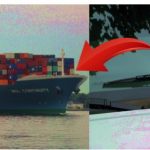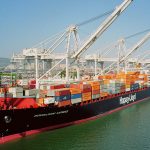Japan’s Big 3 Becoming ONE in Practice & Name

Kawasaki Kisen Kaisha, Ltd. (K Line), Mitsui O.S.K. Lines, Ltd. (MOL), and Nippon Yusen Kabushiki Kaisha (NYK) have given a name to their upcoming joint venture. In a joint press release yesterday, May 31st, Japan’s three largest shipping companies announced the company they merge into will be called “Ocean Network Express.”
Ocean Network Express. Now make that an acronym. ONE.
ONE is a very apt name, describing what these three ocean carriers will be turning into.
The new name’s acronym certainly didn’t happen by accident. Already, K Line, MOL, and NYK have launched a website for the upcoming merged company that plays up the significance of the name. As well as using a bit of word play with the title phrase “ONE Vision” at one point, here’s what the merging carriers have to say about ONE:
Our name conveys our integrity as a company—three leading marine transport companies working together to spark a revolution for the global container shipping industry. We will champion human potential and combine all our strengths to deliver better service, more routes, and improved ICT solutions that will exceed our customers’ needs around the world—now and well into the future.
This integrated global shipping partnership will contribute to our customers’ success and improve life, society, and the planet as a whole.
The site also highlights how this merger moves Japan’s Big 3 carriers up in the worldwide carrier rankings by capacity. With a capacity of 1.4 Million TEU, ONE will be 5th in the international shipping market with approximately 7% of the global share.
In an American Shipper article, Hailey Desormeaux shares the current rankings of K Line, MOL, and NYK:
According to ocean carrier schedule and capacity database BlueWater Reporting’s Carrier Ranking Report, based on operating fleet capacity, NYK is the eighth largest carrier in the world with 594,699 TEUs, while MOL comes in at 11th with 540,942 TEUs and “K” Line takes 14th place with 353,220 TEUs.
The merging of “Japan’s Big 3” is yet another example of shrinking competition among carriers.
As carriers have struggled with profitability in the face of overcapacity and low freight rates, buyouts, mergers, bankruptcy, and carrier alliances have made the competition pool of shipping lines in international shipping smaller and smaller.
In opposition to shipper’s worries about shrinking carrier competition, K Line, MOL, and NYK reiterate in their press release their stance of the new company providing a benefit for shippers:
The move will allow Ocean Network Express to better meet customers’ needs by providing high-quality, competitive services through the consolidation and enhancement of the three companies’ global network and service structures.
The other piece of information that is most notable in the press release is the planned launch date of the joint venture (JV):
… The establishment of new JV will officially be announced once all anti-trust reviews are completed. The service commencement date for Ocean Network Express is April 1, 2018.
That date can also be found on ONE’s website.
The biggest obstacle for that launch date is making it through all the anti-trust reviews by maritime regulators around the world. At the beginning of this month, we blogged about the FMC rejecting the Big 3’s Tripartite Agreement.
That was certainly a setback for K Line, MOL, and NYK in their merger plans but will not stop the companies from merging, only keeping them from acting as a merged entity before the shipping companies actually merge.





Jared, the FMC “action” (actually an in-action) is NOT a set back, the FMC admitted they didn’t have jurisdiction over
mergers of the type that the Japanese presented. Some learned attorneys have commented “why did they file it in the first
place?”. The simple answer is/was, out of an abundance of caution.
In my maritime career, which started in March 1972, I’ve seen first 7, then 6 then 5, then 4, then three then ONE Japanese
carrier. In 1972 they were combined very large in the TP trades as well as Asia/Europe, supported by the Japanese Trading Houses
and indirectly by the Japanese government. Times changed, they are in the containerized world three mid-sized
carriers knowing they can’t survive in that mode. As ONE, in two years they will be the 5th largest carrier in the world,
58% smaller than Maersk Line, 42% smaller than MSC at #’s 1 and 2 respectfully.
As part of The Alliance, hooking up with UASC will give them enough big ships, with MOL’s order for them now in
implementation, for a competitive string of vessels for the Asia/Europe market, but is that enough to really make
them competitive in that market – one string?
So more power to them in trying to remain relevant and one day, with fair winds and following seas, profitable.